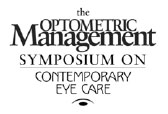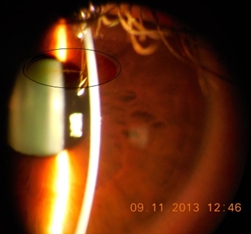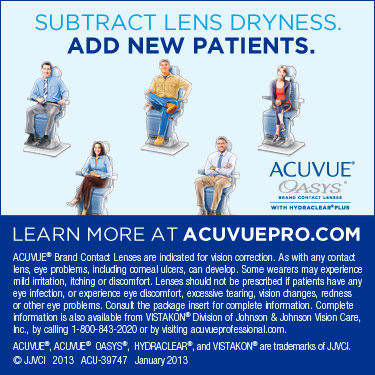

|
The holiday break is a great
time to encourage families to come to the office for annual examinations, especially
if families did not do so prior to the beginning of the school year. I've seen study
after study show that the non-contact lens wearing patient, rather than the eyecare
practitioner, is usually the one to initiate dialogue about wearing contact lenses.
Be proactive about your recommendations for contact lens wear—especially in the
teenage population. These patients will thank you for it.
|

|
The Vision Care Institute, LLC, an affiliate of Johnson & Johnson Vision Care, Inc. has achieved a major milestone with 100,000 eyecare professionals attending courses throughout its network of 14 sites worldwide.
Launched in 2004, The Vision Care Institute was a first-of-its-kind learning destination and has remained the only institution of such magnitude sponsored by a vision care company. It has evolved from one institute in the U.S. to sites across four continents. To date, there have been over 4,000 courses taught by 257 faculty members in 30 languages to accommodate attendees from 56 countries.
The Vision Care Institute in Jacksonville, Fla. opened in 2004 and has offered about 280 classes to date.
Through both lectures and hands-on training, attendees improve technical skills, expand clinical knowledge, and gain new patient communication skills and management techniques, all of which can have a measurable effect on their practice and patient outcomes. Today, a wide range of pioneering techniques are employed at The Vision Care Institute from electronic headgear that demonstrates eye movement and contact lens stability, to the use of mannequins to show UV exposure to the eyes. In other classes, simulation software provides coaching on patient communications.
For more information, please visit www.thevisioncareinstitute.com.
|
|
The MSD Corporation, the owners of msd scleral contact lens design, announced two new global partnerships: Ortolens in Serbia/Croatia and Happy Vision in Korea. These new partners join the company’s existing network which includes Blanchard Contact Lens in the USA, and Les Laboratories Blanchard and Cardinal Contact Lens in Canada.
Receiving KFDA approval in the Korean market is a milestone for the company. These partner companies will strengthen the brand in all international markets and continue to establish MSD as a leader in scleral lens technology.
MSD Corporation’s commitment to research and development resulted in the patented msd mini-scleral lens design for KC patients, post graft, post Lasik, and other traumatized eyes. MSD Corporation is based in Canada and can be contacted at 780-426-6386 or info@viscon.net
.
|
 Earn up to 25 COPE and Florida Board approved credits and 12 CEEs (TQ credits) before year-end at the Optometric Management Symposium on Contemporary Eye Care, December 6-8, 2013 at Disney's Contemporary Resort in Lake Buena Vista, Florida. This popular annual symposium provides the perfect balance of timely, disease management courses and practice-building courses with plentiful networking and leisure time to enjoy all that Disney resorts and theme parks have to offer. Earn up to 25 COPE and Florida Board approved credits and 12 CEEs (TQ credits) before year-end at the Optometric Management Symposium on Contemporary Eye Care, December 6-8, 2013 at Disney's Contemporary Resort in Lake Buena Vista, Florida. This popular annual symposium provides the perfect balance of timely, disease management courses and practice-building courses with plentiful networking and leisure time to enjoy all that Disney resorts and theme parks have to offer.
The educational program is presented by the Pennsylvania College of Optometry, Salus
University. For agenda, more information and to register, visit
www.OMConference.com.
– ADVERTISING
|
|
Optometrists who have made a significant and long-lasting impact on the profession have the chance to be honored by a nomination to the 2014 National Optometry Hall of Fame. Inductees will be honored at Optometry’s Meeting in June 2014 in Philadelphia, PA.
Eligibility requirements are: a nominee must be an optometrist with more than 20 years of service in optometric clinical care, private practice, federal service, academia, research, or industry or is currently retired with records of dedicated service, lifetime achievements, and enduring lifetime contributions.
The selection criteria include:
- Nominees should be recognizable through their national stature.
- Nominees should have made a significant and enduring impact on the profession.
- A nominee’s full range of contributions should be represented, e.g. professional leadership, academic leadership, research contributions, as well as other areas of significance.
- Diversity should be considered in the selection process.
- A balance of historical and current (but very well established) achievements should be considered.
Optometrists nominated for the 2013 AOA Distinguished Service Award will automatically be placed into the National Optometry Hall of Fame selection pool for 2014.
The National Optometry Hall of Fame is administered by Optometry Cares — the AOA Foundation. The nomination form is available online and the deadline for online submissions is January 15, 2014. You can view the submission form and learn more by visiting www.aoa.org/HallofFame.
|

|
|

|
|

A Fleischer Ring is an partial or complete iron deposition ring in deep epithelium
encircling the base of the cone. It is a characteristic in eyes with (early) keratoconus
and appears as yellowish to dark-brown-colored ring. Visual acuity was 0.9 with
GP keratoconus lens.
We thank Dave Block for this image and we welcome photo submissions from our other
readers! It is easy to submit a photo for consideration for publishing in Contact
Lenses Today. Simply visit
http://www.cltoday.com/upload/upload.aspx to upload your image. Please
include an explanation of the photo and your full name, degree or title and city/state/country
^ Back to top
|

|
TFOS and CLD
The Tear Film and Ocular Surface Society (TFOS) recently reported on their International
Workshop on Contact Lens Discomfort (CLD), chaired by our editor Dr. Jason Nichols,
in multiple publications in Investigative Ophthalmology and Visual Science.
This effort took 18 months and 79 experts to complete, and resulted in an excellent
evidence-based report on various aspects of CLD. One subcommittee focused on contact
lens materials, design and care.1 This paper is an amazingly comprehensive
literature review of how contact lens materials and designs impact CLD. Though there
is a wealth of information on these various aspects, the paper summarizes how difficult
it is to pinpoint the actual causes of CLD because there are so many possible reasons
why contact lenses are not comfortable. For example, some obvious factors include
lens modulus, surface dehydration, friction and lubricity, lens movement, and edge
design, but their effects are difficult to isolate in well-controlled studies. This
paper raises some good research ideas that will hopefully help us better manage
patient complaints of discomfort. It is a great read for any contact lens fitter
who thinks about how to best provide the most comfortable lenses for their patients.
Jones L, et al. The TFOS International Workshop on Contact Lens Discomfort: Report
of the Contact Lens Materials, Design, and Care Subcommittee. Invest Ophthalmol
Vis Sci. 2013 Oct; 54(11): TFOS 37-70.
^ Back to top
|
|
Microbial Analyses of CL-Associated Microbial Keratitis
Fortunately, most cases of contact lens microbial keratitis that are caught early
respond well to monotherapy with modern fluoroquinolones and don't require culture.
However, when the infection does not respond to therapy or when the infiltrate is
large and/or central, corneal cultures are often required. Negative cultures in
cases of presumed microbial keratitis are not uncommon and complicate the treatment
plan. A recent study from patients at the L.V. Prasad Eye Institute in India sheds
some new light on this topic.
The authors performed a retrospective study of 125 eyes presenting with presumed
infectious keratitis associated with contact lens wear over a 10 year period. Among
the samples tested, positive cultures were obtained 40% of the time from the cornea,
in 92% of the cultures from the worn contact lenses, and in 80% of the lens case
cultures. Whenever corneal cultures were positive and data existed for cultures
of the lenses and storage cases, contact lenses yielded the same microbes as the
cornea in 94% of eyes, and storage cases yielded the same microbes as the cornea
in 77% of eyes. Importantly, these were monocultures of the same microbe isolated
from the cornea in the contact lens and lens case cultures. The odds of having a
positive corneal culture were 37 times higher when patients presented to the clinic
two weeks after the onset of symptoms.
This data is striking and speaks to routine contact lens cultures as being perhaps
more valuable than corneal cultures in cases of suspected microbial keratitis. Routinely
gathering and culturing the lens worn at the time of the event may be more cost
effective than waiting for potentially inconclusive corneal cultures.
Konda N, Motukupally SR, Garg P, Sharma S, Ali MH, Willcox MD. Microbial Analyses
of Contact Lens-Associated Microbial Keratitis. Optom Vis Sci. 2013 Nov
7. [Epub ahead of print]
^ Back to top
|

|

|
|
DISC Lens Slows
Myopia Progression in Hong Kong Chinese schoolchildren: A 2-Year Randomized Clinical
Trial
|
|
DISC Lens Slows Myopia Progression in Hong Kong Chinese schoolchildren: A 2-Year
Randomized Clinical Trial
The purpose of this study was to determine if a 'Defocus Incorporated Soft Contact'
(DISC) lens wear slows childhood myopia progression
A 2-year double-blind randomized controlled trial was carried out in 221 children
aged 8-13 years, with myopia between -1.00 and -5.00 Dioptres (D) and astigmatism
=1.00 D. Subjects were randomly assigned to the DISC (n=111) or single vision (SV;
n=110) contact lens group. DISC lenses incorporated concentric rings, which provided
an addition of +2.50 D, alternating with the normal distance correction. Refractive
error (cycloplegic autorefraction) and axial length were measured at 6-month intervals.
Differences between groups were analyzed using unpaired t test.
In total, 128 children completed the study, n=65 in the DISC group and n=63 in the
SV group. Myopia progressed 25% more slowly for children in the DISC group compared
with those in the control group (0.30 D/year; 95% CI -0.71 to -0.47 vs 0.4 D/year;
95% CI -0.93 to -0.65, p=0.031). Likewise, there was less axial elongation for children
in the DISC versus SV groups (0.13 mm/year; 95% CI 0.20 to 0.31 vs 0.18 mm/year;
95% CI 0.30 to 0.43, p=0.009). Treatment effect correlated positively with DISC
lens wearing time (r=0.342; p=0.005). Indeed, myopia in children who wore the DISC
lenses for five or more hours/day progressed 46% (mean difference=-0.382 D, p=0.001;
95% CI -0.59 to -0.17) less than those in the SV group.
The authors concluded that the daily wearing of a DISC lens significantly slowed
myopia progression and axial elongation in Hong Kong schoolchildren. The findings
demonstrated that simultaneous clear vision with constant myopic defocus can retard
myopia progression.
Lam CS, Tang WC, Tse DY, Tang YY, To CH. Defocus Incorporated Soft Contact (DISC)
lens slows myopia progression in Hong Kong Chinese schoolchildren: a 2-year randomised
clinical trial. Br J Ophthalmol. 2013 Oct 29. doi: 10.1136/bjophthalmol-2013-303914.
[Epub ahead of print]
|
|
|

|
|
A Proud Supporter of

Important Links:
To report adverse contact lens reactions visit:
http://www.accessdata.fda.gov/scripts/medwatch/ or call (800) FDA-1088.
To report possible grievances related to the Fairness to Contact Lens Consumers
Act or associated Contact Lens Rule visit:
https://www.ftccomplaintassistant.gov/.
CLToday Services:
Subscribe;
Unsubscribe; Submit Clinical
Image
Submit news to cltoday@pentavisionmedia.com.
Send your comments and fitting tips to
cltoday@pentavisionmedia.com. Please include your full name, degree or title
and city/state/country.
For more information on Contact Lenses Today including archives of previous
issues, please visit our website at www.cltoday.com.
For the latest articles on contact lenses, important clinical information and helpful
tools related to the contact lens practice visit the Contact Lens Spectrum
website at www.clspectrum.com.
© 2013 All Rights Reserved Contact Lenses Today and CLToday
are registered trademarks of:
PentaVision LLC, 323 Norristown Road, Suite 200, Ambler, PA 19002 | 215-646-8700
© 2013 PentaVision LLC All Rights Reserved.
|

|
|
|













 Earn up to 25 COPE and Florida Board approved credits and 12 CEEs (TQ credits) before year-end at the Optometric Management Symposium on Contemporary Eye Care, December 6-8, 2013 at Disney's Contemporary Resort in Lake Buena Vista, Florida. This popular annual symposium provides the perfect balance of timely, disease management courses and practice-building courses with plentiful networking and leisure time to enjoy all that Disney resorts and theme parks have to offer.
Earn up to 25 COPE and Florida Board approved credits and 12 CEEs (TQ credits) before year-end at the Optometric Management Symposium on Contemporary Eye Care, December 6-8, 2013 at Disney's Contemporary Resort in Lake Buena Vista, Florida. This popular annual symposium provides the perfect balance of timely, disease management courses and practice-building courses with plentiful networking and leisure time to enjoy all that Disney resorts and theme parks have to offer.






